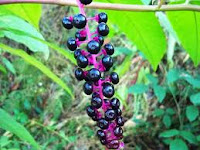Pokeweed is a member of the Phytolaccaceae family, also called by a number of other names such as Poke root and American nightshade. Like Belladonna it is poisonous and if handling it, especially if you have scratches on your hands, wear gloves. It is native to North and Central America but has naturalized in parts of Britain
It can grow to heights of six feet (around 2 metres) and may have a spread of around 5 feet. It flowers in August and September, and these are followed by fruit, which looks tasty but is poisonous to children and animals. Only birds seem immune to it and scatter the seeds through their droppings.
Despite its poisonous nature the young shoots and leaves are considered “gourmet” food as is asparagus, and are the basis of “poke sallet” in southern US
The leaves are rich in vitamins A and C and some of the B-complex ones, including thiamin (B1), riboflavin (B2) and niacin (B3). They also contain the minerals calcium, phosphorous and iron.
The juice from the berries (which have the least amount of poison than the rest of the plant) has been used by Native Americans to dye feathers and arrow shafts and they produce an attractive red dye which is temporary and can be washed out. A red ink can also be obtained from the berries, but again this, like the dye is not permanent.
The Native Americans used the extremely poisonous roots externally in poultices for sprains and swellings, and in preparations for skin troubles and rheumatism. These are violently emetic and purgative and may be fatal, causing paralysis of the respiratory organs. However were also employed by Native Americans as cancer and syphilis remedies and as a heart stimulant in the same way as digitalis from the foxglove is used.
In traditional medicine pokeweed has been used for breast cancer, mastitis, mumps, sore throats, swollen glands, bronchitis, constipation, fungal infections, inflammation of the joints, and externally for skin problems, piles and itching.
Clinical studies have discovered a protein called pokeweed antiviral protein (PAP) which has had anti-tumour effects on mice and this has also shown some activity against the HIV virus. However as yet there are no indications that this is effective in humans. The plant’s extracts have proved to be effective against water snails which carry bacteria and studies into this activity are ongoing as are the other studies mentioned.
The roots infusion was used for swellings and sprains and harvested in the autumn for these purposes and dried for later use. These have narcotic, expectorant, anti-inflammatory, hypnotic and purgative properties. The fruit with its milder action than the root has been used for cancer, tumours and sore breasts. The leaves also have emetic and expectorant properties.
The poisonous substances are saponins-like and the roots can be chopped and boiled to produce a soap substitute, as can other plants such as soapwort and reetha (soap nut). This plant should not be used for home remedies but may be safe in homeopathic remedies for muscular tissues, throat, breast and painful joint.






No comments:
Post a Comment